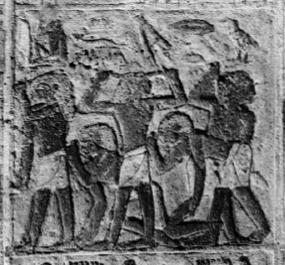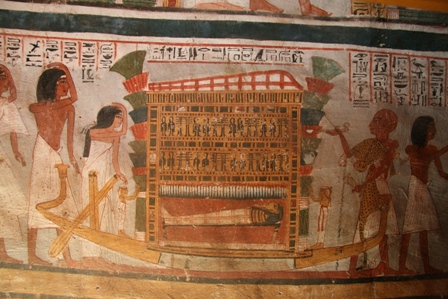In Ancient Egypt art not always all scenes of a decoration were connected. But when it happens, it is important to guess the correct order of them and “read” the story.
On January 13th we saw how a small scene from tomb of Qar could be a summarized or codified representation of the Opening of the Mouth ceremony. But this is not the only surprise of this Egyptian tomb.
According to Simpson the normal order of the funerary scenes in the north wall was, following a more occidental logic, from the top downwards; so from left to right in the upper register and from right to left in the lower one. The sequence would start with the three figures of the Drt mourner, the wt (embalmer) and would end with the arrival to the building on the left, which was considered as the embalming place[1]. However, the Egyptian logic in art was different from ours.
The word identifying the building on the left is uabet , which means a “pure and clean place”[2], but not necessarily just for “embalming”. We also know that uabet from the Middle Kingdom also meant “tomb”[3]. Maybe the building in the scene was the Qar’s tomb. If we think like that, the decoration then maybe should be read in a different direction; in fact sometimes Egyptian artists designed a decoration from down to top.
The sequence would start at the right of the lower register. The cortège moves the coffin on the boat until the uabet building, the tomb (this would be a reproduction of the Egyptian mythical voyage to Abydos), the burial place and also the embalming place. We notice that the corpse is being accompanied by the two Drty mourners with short hair, the wt (embalmer) and the lector priest.
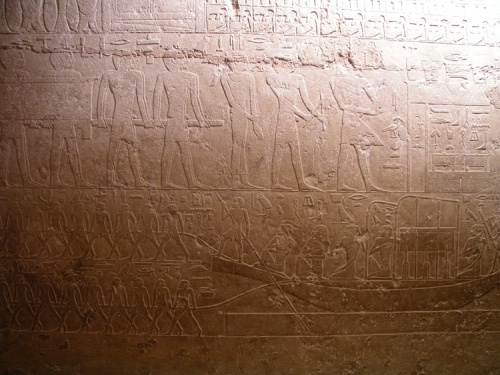
The coffin on a boat is being moved to the tomb. The mourners Drty are at both extremes of the coffin, In the prow sit the lector priest and the embalmer. Tomb of Qar in Giza. V-VI Dynasty. Photo: http://www.archaeology-archive.com
In the upper register the artists represented what it was happening inside the uabet building. There are always three main figures: the lector priest, the wt (embalmer) and the Drt mourner. And their presence allows us to divide the upper register in three scenes:
1) They three and the coffin transport. That would be the staff and the mummy getting into the tomb.

The Drt mourner, the embalmer and the lector priest in front of the w3t. Tomb of Qar in Giza. V-VI Dynasty. Photo: http://www.allposters.com
2) They three inside the w3t. This Egyptian word meant “way” or just “a part of a place”[4]. Inside the w3t there is:
- The tools of the Hmt (artisans),
- The tools of the lector priest.
- All necessary for the purification of the feeding[5]. It should refer to the final food offerings.
- The icon shows that in this w3t there is water.
All these four points refers to what the staff needed for the Opening of the Mouth ceremony, as we can see in some tombs of the New Kingdom.
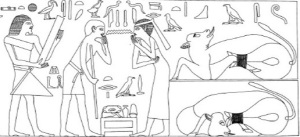
Funerary practice in the mastaba of Qar with lector priest, the embalmer and the mourner Drt; the scene is closed by two images of an ox. V-VI Dynasty. Giza. Image: W.K. Simpson.
3) They three during the D3t r3 and the slaughter of the ox. We have already seen that this image could be a way of representing the Opening of the Mouth ceremony.
Summing up, the decoration of the north wall in the tomb of Qar could be read from down to top. The artist would have “narrated” the arrival of the funerary procession to the tomb, the resurrection rites practiced on the mummy and for that reason finally at the final top of the wall Qar sits alive in front of his funerary offerings.
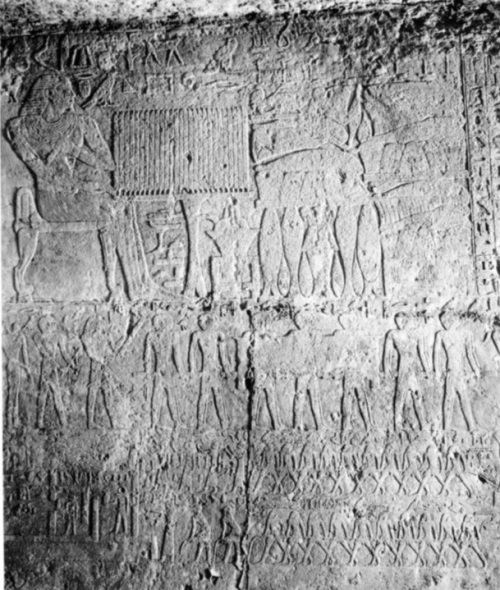
Qar sits in front of his funerary offerings. Scene at the top of the north wall. The funerary ceremony is below. Tomb of Qar in Giza. V-VI Dynasty. Photo: W. K. Simpson.








